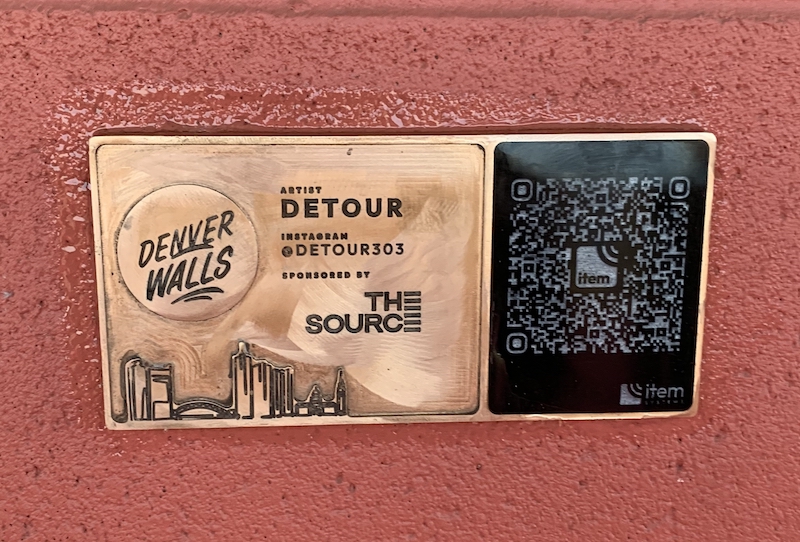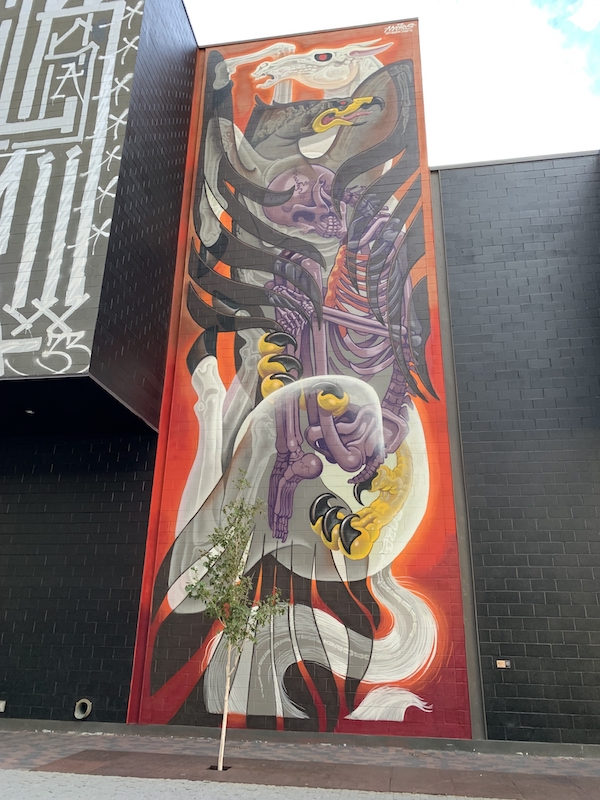COZ brought non-fungible item technology to the DENVER WALLS festival, which ran from Sep. 22 through Oct. 3. Denver’s River North neighborhood, a district already well known for its vibrant murals and street art scenery, was ground zero for the event, which demonstrated a potential future where blockchain technology can amplify public art experiences.
DENVER WALLS comprises 17 murals scattered throughout the RiNo area of the city, some painted by local artists like Detour and Casey Kawaguchi, and others by international muralists brought in for the event, such as Nychos and Squid Licker. Each mural has an accompanying bronze plaque embedded with ITEM Systems NFI technology, created in partnership between COZ and AxLabs, allowing patrons to interact with the art in ways that transcend simply viewing the murals.
In an interview with Blockster, COZ CEO Tyler Adams said, “Through this fusion of blockchain and art, we are showcasing Denver as an inclusive haven for those pushing the boundaries of digital expression, firmly positioning the city as a leader in digital innovation.”

Bridging art and technology through NFI
There are two ways to use mobile devices to interact with the plaques. The first is to scan the QR code, which then takes the user to a website where they can learn more about the artist, connect with them on social media, and view a map showing the locations of all DENVER WALLS murals. There are at least a couple of benefits to interacting with the art via the QR code – the technology is familiar, and it works quickly and easily, provided the user is connected to the internet.
However, QR scanning isn’t as secure or robust as the second method – “tapping” into the NFI transmitter embedded in the plaque. By simply touching their mobile device to the plaque, users can access the same information provided by QR scanning, with the additional benefit of “proving” they visited the mural they’ve tapped. Whereas QR codes can be photographed and sent to anyone, the user must be physically present to utilize the tapping functionality. This will become more important in the future of the RiNo district, when the COZ team executes plans to work with local businesses on marketing initiatives. For example, businesses could give exclusive offers or discounts to patrons who’ve physically visited all 17 murals. The NFI technology, in tandem with the Neo blockchain, will provide the framework and evidence needed for such an initiative, where QR scanning would fall short.

These physical activations of digital technology gamify the mural exploration, combining aesthetic appreciation with digital rewards and enhancing the connection between art, technology, and the viewer. The NFI feature not only deepens engagement with the art but will also symbiotically support local commerce, intertwining community, technology, and art in a seamless and mutually beneficial experience.
“The goal of DENVER WALLS is to rejuvenate our urban environments and elevate Denver’s reputation for artistic expression and community spirit,” explained Ally Grimm in an interview with nft now. Grimm, a Denver artist (aka A.L. Grime) and DENVER WALLS organizer, added, “Working with the COZ team to incorporate a digital element into each mural that supports local businesses and enriches the viewer’s experience was a no-brainer when the opportunity arose.”
Origins of the collaboration and looking to the future
The opportunity arose when COZ and DENVER WALLS initially connected at Consensus 2023 in April, where Grimm, along with DENVER WALLS media marketing manager Sage Storm visited the Neo booth. As they onboarded into the Neo ecosystem via the OneBand, Grimm and Storm started thinking about how they could implement similar technology for their upcoming mural festival. The vision for NFI technology to be part of DENVER WALLS took off from there.
This inaugural blending of NFI technology and street art is not just a festival; it’s a forward-thinking blueprint illustrating the multifaceted benefits and potential embedded in the convergence of technology, art, and community. And even as the team wraps up its activity for this year’s event (12 of 17 plaques have been installed at the time of this writing), COZ and DENVER WALLS are looking to the future. Plans are underway for the 2024 edition of DENVER WALLS, which will likely see the installation of additional ITEM Systems NFI-embedded plaques for a new fleet of murals.
The integration of ITEM Systems technology into the DENVER WALLS festival serves as a prototype, showcasing the possibilities arising from the fusion of art and blockchain technology. The endeavor goes beyond just showing off the tech; it lays down a framework where blockchain and art can coalesce to enhance real-world, tangible experiences for communities and artists alike.
 neonewstoday.com
neonewstoday.com
